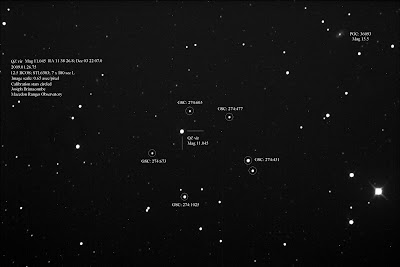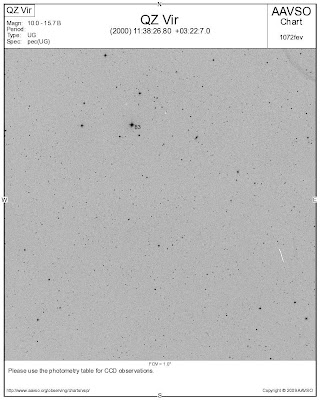.jpg)
Dwarf Nova QZ Virginis
Annotated - Image Credit: Dr. Joe Brimacombe

AAVSO Locator Chart for QZ Vir
For all of you variable star fans, there's a new kid on the block - Dwarf Nova QZ Virginis. It was originally discovered by T. Meshkova on Moscow photographic plates in 1944 and had a magnitude range of 12.9 to as little as 14.5 But what is it? Try a cataclysmic variable star - one that our good friends down under caught just for Universe Today readers!
According to recently released AAVSO Special Notice #144, dwarf nova QZ Vir (once known as T Leo) is currently in outburst, and it appears that this outburst is a supermaximum. Says M. Templeton, "The most recent visual estimate of QZ Vir puts the star at visual magnitude 10.2 (JD 2454857.6201; W. Kriebel, Walkenstetten, Germany). Time series photometry by W. Stein (New Mexico, United States) on 2009 Jan 25 indicates the presence of superhumps in the light curve. Observations by P. Schmeer (Saarburecken-Bischmisheim, Germany), E. Morelle (Lauwin-Planque, France), ASAS-3 (Pojmanski 2002, AcA52, 397) and R. Stubbings (Tetoora Road, Vic., Australia) published on VSNET. (T. Kato; vsnet-alert 10980) suggest QZ Vir may have had a short precursor outburst lasting 2-3 days and fading immediately before the rise to supermaximum. All observations, including both visual estimates and CCD time-series photometry, are strongly encouraged at this time."
Of course, it didn't take a lot of encouragement - only some clear skies to get astrophotographer and serious researcher Joe Brimacombe of Southern Galactic to set his telescope towards QZ Virginis and image for us. All we needed to do was provide the following coordinates:
RA: 11 38 26.80 , Dec: +03 22 07.0
As you can see, learning proper stellar coordinates is essential to practicing astronomy. Without them, a stellar field is simply a stellar field as it would be next to impossible to distinguish one background star from the next. While some of us understand what these strange sets of numbers mean - maybe some of our readers don't. Let's take just a moment out from our busy days and learn, shall we?
RA stands for Right Ascension. It is the celestial equivalent of terrestrial longitude. RA's zero point is the Prime Meridian, located in the constellation of Aries where the Sun crosses the celestial equator at the March equinox. Each set of numbers is then measured eastward in three sets - hours, minutes, and seconds, with 24 hours being equivalent to a full circle. Declination, or "Dec" is comparable to latitude, projected onto the celestial sphere, and is measured in degrees north and south of the celestial equator. Points north of the celestial equator have positive declinations, while those to the south have negative declinations. These are also measured in three sets of numbers - degrees, minutes, and seconds of arc.
Now that you know, how do you use them? Chances are, if you have a telescope that has an equatorial mount, you already have the tools in your hands - called "setting circles". These same sets of numbers are waiting right on your telescope for you to set them! Once your telescope is accurately polar aligned, you just use the setting circles to dial in these numbers and you'll be right in the approximate area. For those with electronic setting circles, it's just a matter of inputting the correct coordinates and comparing star fields. Once the general area is found, you simply need to understand how big the field your eyepiece gives and compare it to a star chart - like this one supplied by the AAVSO for QZ Vir.
Make note of your observations and compare the suspect nova to other stars of known magnitude nearby. When you're done - don't keep your observations to yourself! Please report all observations to the AAVSO using the name "QZ Vir" and contribute!
No comments:
Post a Comment